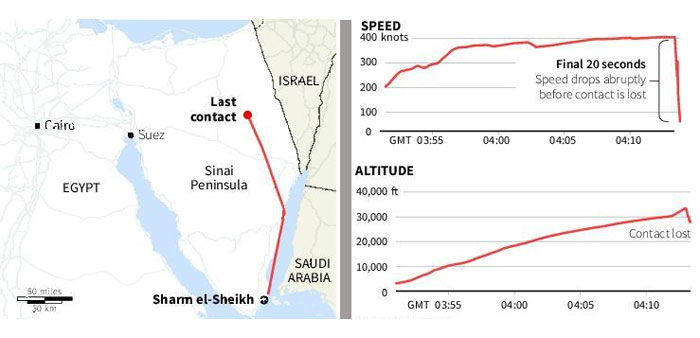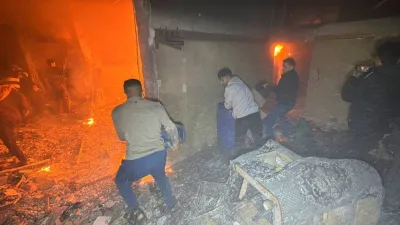AFP/Paris
Aviation experts point to a range of scenarios to explain the crash Saturday of a Russian jetliner in Egypt's Sinai Peninsula, killing all 224 people on board.
International investigators have begun sifting through the wreckage and the Egyptian government says the plane's two "black box" flight recorders have been recovered.
A senior Russian official, Viktor Sorochenko, says the plane disintegrated "in the air".
The Egyptian branch of the Islamic State group says it downed the plane, but the Egyptian and Russian governments cast doubt on the claim.
Following is a question-and-answer examination of the main issues after interviews with aviation experts.
What can we learn from the pictures of the crash site?
Jean-Paul Troadec, former director of France's civil aviation accident investigation office (BEA): "Having seen these photos, the hypothesis of an attack and that of an accident both remain open.
"The examination of the debris and the analysis of the flight recorders will allow us to quickly establish which of those hypotheses is the most plausible."
What could the debris show?
"If there was an attack, it could be shown by the way the wreckage is dispersed, but above all it's the debris -- if there are traces of explosives, and if the body of the plane has been (blown) open, it could show the possible presence of a bomb," Troadec said. "That is one hypothesis, but a technical problem cannot be ruled out either."
Troadec also noted, "There are no small pieces of wreckage, suggesting it did not nosedive."
If the plane did break up in mid-air, what could have been the cause?
It could have been caused by a catastrophic technical failure, according to aviation expert Robert Galan.
"There are several things that can cause a major problem mid-flight and cause the plane to disintegrate before reaching the ground, without it being caused by an attack," he said. "These include engine that exploded or shifting cargo." But internal faults in aircraft very rarely lead to explosions, he said.
If it was an attack, what device was used?
In the event of a blast, "the plane might have exploded in mid-air either due to a suicide bomber or a bomb on board, or even after a missile was fired at it," Galan said.
"If the plane was cruising at an altitude of 9,000 metres (29,500 feet), it is highly unlikely that the Islamic State group has the means to shoot it down because you would need advanced radar."
However, he added, "it is possible that, if the plane had had technical problems and descended, then IS could have shot it down, as they have medium-range weapons. But that's a bit contrived as a theory."
How much credit should be given to Islamic State claim?
The Egyptian and Russian governments have challenged the claim from the Egyptian branch of IS, which says it attacked the plane in revenge for Russian bombing in Syria. The group is waging a deadly insurgency in its bastion in the northern Sinai, where they commit near-daily attacks on the army and the police.
Mathieu Guidere, a terrorism expert at the University of Toulouse in France, said the claim "is credible."
"The Twitter account and the other sites that have published the claim have never published anything false. The statement also carries the same style as other statements from the group," he said.



